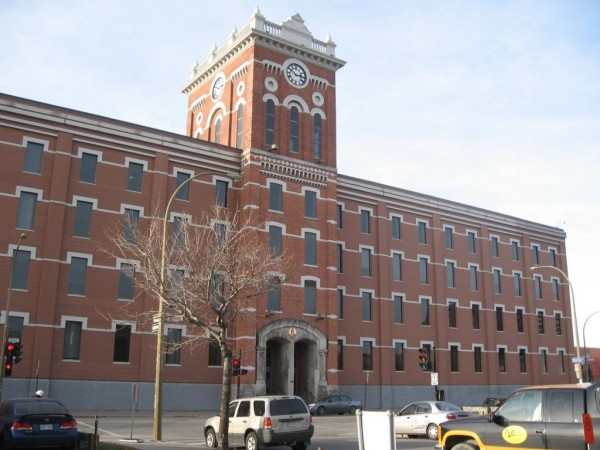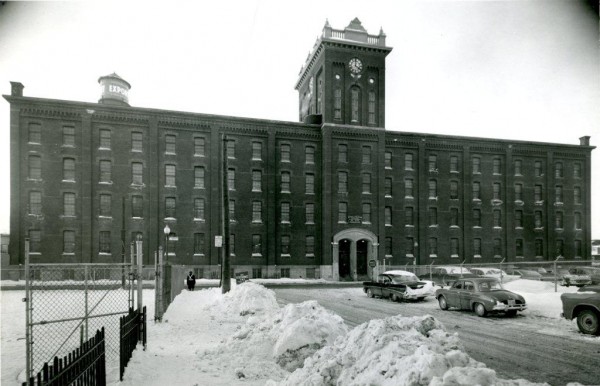Eliot Perrin performs archival work for the Macdonald Stewart Foundation here in Montreal.
At the corner of Rue Ontario and Rue d’Iberville sits the Macdonald Tobacco Works. This red brick structure was built by owner William C. Macdonald in 1874 at a time when the areas of Ste. Marie and Hochelaga, previously farmland, were establishing themselves as sites of industrial development. As many individuals quit the rural hinterlands to seek employment in the city, Montreal experienced a marked population increase. The industrial production in the area encouraged many individuals and families to decamp to Hochelaga, providing an ever-growing labour force for the area. Parish records indicate that employees were as young as twelve and, in the early decades, the factory employed roughly equal numbers of women as men. Over the decades, multiple generations of neighbourhood families would find employment at the factory.
At first, the factory produced solely plug chewing tobacco. As tastes changed, Macdonald’s product line diversified, later incorporating pipe tobacco and cigarettes. New brands were introduced to market these products and British Consols and Export Cigarettes would become household names. Thanks to its growing popularity and wartime distribution, Export especially would come to dominate the urban advertising landscape. A Scottish Lassie mascot that reflected the Scottish roots of the company graced the cigarette packages, playing cards, hockey scoreboards and billboards became one of the most prominent Canadian brands for decades and one that with which many blue-collar individuals were keen to associate.
Now owned by Japan Tobacco International, the Macdonald Tobacco Works represents one of the few remaining working industrial sites in this area of the city. New condominium developments are springing up to the west and east of this area, bringing new household incomes and shifting demographics. In addition, smoking, as an industry in Canada, is dwindling due to he decline in the number of smokers, the availability of black market cigarettes and the massive lawsuits that tobacco companies currently face across the country.
Considering these changes, it is difficult to imagine the factory maintaining residency here for decades to come. This poses some questions. Are heavy industry and 21st century urban developments irreconcilable? If this factory were to close permanently, what would lie in store for the building itself? What would become of the working-class identity of the neighbourhood? Is gentrification inevitable? Macdonald Tobacco’s historic rival, Imperial Tobacco, has seen its former factory restored and converted to condos in St-Henri. Whatever fate awaits this building, my hope is that its structure is maintained, its awful red siding removed to re-expose the brick work and the Scottish Lassie painted image retained to provide a visual reminder of the working-class roots of this area and the products that its residents produced.



8 comments
J’habite tout près de cet immeuble. Je ne comprends pas pourquoi il a été recouvert par cet affreux revêtement brun alors qu’en dessous il semblerait y avoir de la très belle brique ancienne. On arrête pas le progrès ça c’est certain.
@ Luc Forest : L’édifice a été isolé de l’extérieur. Voilà pourquoi la brique est recouverte.
I think it is a wasted opportunity to either tear down these buildings or leave them to waste away. Every effort should be made to preserve the building in its original form and to use these buildings. Turn them into housing (affordable housing as well!), cultural centers, business offices, etc. There lies so much potential. These buildings not only preserve our history but also provide much needed architectural beauty across our urban landscape. New buildings never look at beautiful or unique as the old.
Thanks for sharing this piece of history. I also live in this neighbourhood and was told via a public consultation 2 years ago that the land this building sits on would remain for commercial use, not residential (with the vague exception of the part adjacent to the park in this building’s back yard) BUT anything can and does change and sadly the easiest thing for a city to do is hand things over to a private developer. Anyhow, it would be awesome if the city could keep it’s commercial designation to create more employment opportunities and partly in line, if feasible, with other arts-related initiatives like the Grover and Chat des Artistes buildings.
Merci Éric pour le lien tant pour l’article que pour le site SpacingMontreal. Comme tu sais, je suis un voisin à 600 mètres sur la rue Iberville. En effet, la conversion en édifice domiciliaire a dû être abandonné un peu après la vente au consortium japonais G.I.T. à cause des coûts obligatoires de décontamination trop onéreux en passant sous la structure en place. Tu as raison ce sont les espaces de production de cigarettes et d’entreposage sur 400 mètres (16,5 m. en hauteur) à l’arrière qui pourraient être démolis, décontaminés et reconstruits en domiciliaire mais le coût serait difficile à rentabiliser aussi. J’attire ton attention sur le stationnement des employés de la Macdonald sur le côté est de la rue d’Iberville (600 m par 40 m) qui ne contient jamais plus de 30-50 automobiles sur les 300 places aménagées J’attire aussi ton attention sur la Coopérative Lézarts sur la rue Parthenais (650 m. à l’ouest) qui va un pas plus loin que la Grover et le Chat des artistes en logeant ses artistes au-dessus des ateliers de production artistiques. Il y aurait donc moyen de maintenir la vocation ancestrale de la Macdonald en Technopole d’agriculture et d’alimentation urbaine (services et experts du domaine, centre de recherche et développement). À l’arrière, les espaces pourraient être maintenu en transformation alimentaire (le tabac est classé comme ¨”aliment”) pour la centaine d’employés actuels mais aussi en permaculture étagée (nouveaux emplois). Les employés, les travailleurs autonomes et leurs familles de la Technopole, de l’usine alimentaire et de la permaculture pourraient loger dans les 720 logements familiaux (3 chambres à coucher) organisés en Cohousing/Kraus-Fitch comme Cohabitat à Québec.
Le gouvernement on mis des substance chimique qu’auparavant on n’avais pas dans le tabac. Ils nous passent un sapin. Moi je suis un gros fumeur et toute a changé qu’il y avait des substances très nocives
Votre pollution sur le pétrole ils n’en parlent pas par exemple de nous éliminée tous
Laissons-nous la liberté d’expresssion d’usage sur le tabac